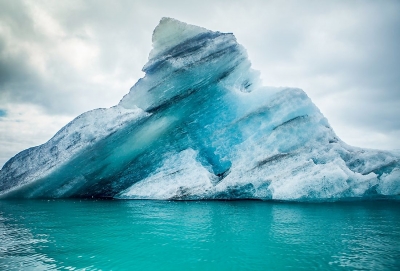
Icebergs are large chunks of ice that break off from glaciers. This process is called calving. Icebergs float in the ocean, but are made of frozen freshwater, not saltwater.
Most icebergs in the Northern Hemisphere break off from glaciers in Greenland. Sometimes they drift south with currents into the North Atlantic Ocean. Icebergs also calve from glaciers in Alaska.
In the Southern Hemisphere, almost all icebergs calve from the continent of Antarctica.
Some icebergs are small. Bergy bits are floating sea ice that stretch no more than 5 meters (16.5 feet) above the ocean. Growlers are even smaller.
Icebergs can also be huge. Some icebergs near Antarctica can be as big as Sicily, the largest island in the Mediterranean Sea. As little as one-eighth of an iceberg is visible above the water. Most of the mass of an iceberg lies below the surface of the water. This is where the phrase “tip of the iceberg” came from, meaning only part of an idea or problem is known.
There are many different kinds of icebergs. Brash ice, for instance, is a collection of floating ice and icebergs no more than 2 meters (6.5 feet) across. A tabular berg is a flat-topped iceberg that usually forms as ice breaks directly off an ice sheet or ice shelf.
The ice below the water is dangerous to ships. The sharp, hidden ice can easily tear a hole in the bottom of a ship. A particularly treacherous part of the North Atlantic has come to be known as Iceberg Alley because of the high number of icebergs that find their way there. Iceberg Alley is located 250 miles east and southeast of Newfoundland, Canada.
In 1912, the Titanic, a large British ocean liner on its way to New York, struck an iceberg and sank in Iceberg Alley. More than 1,500 people drowned. Soon after the Titanic sank, an International Ice Patrol was established to track icebergs and warn ships. That patrol continues today.
Iceberg patrols now use global positioning system (GPS) technology to help locate icebergs and prevent more tragedies like the Titanic. In 1999, the National Ice Center lost track of an iceberg the size of Rhode Island. It was found drifting toward the Drake Passage, an important shipping route south of Argentina. Dr. David Long of NASA’s SeaWinds science team used satellite data to track the iceberg, the first time satellite technology was used for that purpose. Since that time, the SeaWinds team has used satellites to track the world’s ice.
Icebergs that drift into warmer waters eventually melt. Scientists estimate the lifespan of an iceberg, from first snowfall on a glacier to final melting in the ocean, to be as long as 3,000 years.
Credit : National Geographic
Picture Credit : Google




